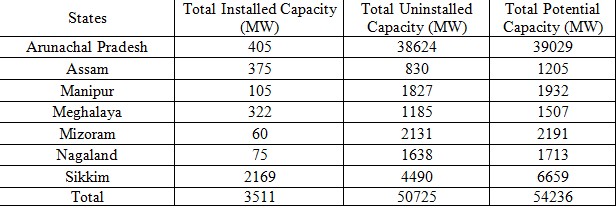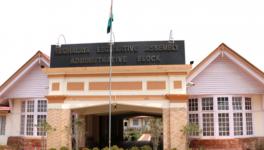The NITI Aayog is Parroting the Old Ideas For ‘Developing’ the Northeast

Image Courtesy: Zee News
A PIB Press Release from the NITI Aayog on Monday stated that the Aayog’s Northeast Forum will meet in Agartala on Tuesday, to discuss six broad themes pertaining to the Northeast: improving road rail and air connectivity, utilising existing potential hydro-power, agriculture and allied sectors, water management, tourism and identifying early bird industries. It seems inconceivable that all these topics will be covered within a day. However, all the chief ministers of the eight states of the Northeast Council will attend the meeting, as will the chief secretaries. At the outset, the broad points laid down as the agenda appear to be exactly what the ‘experts’, the media and the politicians have stated to be panaceas for the regions’ ‘troubles’. However, a deeper look into these ‘solutions’ displays a mismatch of priorities.
On the issue of connectivity, there is little opposition. However, connectivity is a two-way affair. On one hand, it will facilitate easy travel within and from the region. However, the improved connectivity will also facilitate easy travel from outside the region. Considering that the Northeast has seen several ethno-nationalist movements, it is not inconceivable that this demographic change – particularly near the railway stations – will result in reviving some of these dormant movements. These issues could resurface in a big way in states, which do not have land policies barring migrants from owning land. The two states, which do not have these ‘special provisions’, are Assam and the valley areas of Manipur.
Hydro-power is a painful issue for many communities in the Northeast. Manipur’s Loktak project saw around 700 houses gutted by the government. In Sikkim too, the people of Dzongu are opposed to the Teesta IV project. In Arunachal Pradesh, monks from Tawang – the main disputed part of Arunachal Pradesh – have constantly opposed such projects. Yet, hydro-power is still on the agenda—so much for being a representative democracy. The numbers from the Central Electricity Authority reveal what all this salivation is about.

The table shows that the total installed capacity of hydro-power constitutes around 6 per cent of the total potential capacity. Among all the states, Sikkim has the highest installed capacity which constitutes around 32 per cent of its total potential, whereas Arunachal Pradesh has the highest potential capacity and its installed capacity constitutes around 1 per cent of it. What this means, is that there is money to be made in the short term. Engineers, contractors and suppliers all cannot wait for a clearance. None of these characters would have any qualms about destroying or submerging virgin forests and the fauna that goes with it. Blocking rivers also affects downstream communities, who are dependent on rivers for their livelihoods. What development means, in this context is, open to interpretation.
Almost ironically, just after the scope of increase in hydro-power generation, the next point on the agenda is agriculture. The key point on the list for agriculture, is for the region to boost organic farming. However, evidence has time and again suggested that the organically grown food does not have any increased nutrition. The only benefit it can offer to the environment is the inevitable riddance of pesticides, herbicides, fungicides, and fertilisers. This, then, reduces the chances for eutrophication. However, it probably won’t be a very difficult task to complete, since the amount of chemical fertilisers and other products available in most parts of the Northeast is negligible. The rest of the points pertained to extending a number of schemes to the farmers. However, an interesting point mentioned in the agenda talked about boosting the milk production, even though most communities in the Northeast do not consume dairy. Though several communities kept mithun and buffalos, the animals were kept solely for meat. The dairy-consuming communities are mostly in the Himalayas and parts of Assam. Thus, the milk produced in excess is unlikely to be for the consumption of the locals.
Water management and irrigation is another problematic area, when coupled with the hydro-power projects. Before the dams, the people used the freely flowing river water, apart from the rain water, to irrigate their crops. In hilly areas, where jhum cultivation was more popular, varieties of dry rice were sown. It is only in the regions along the streams and rivers, where the wet paddy was cultivated. Now when dams block the natural flow of rivers, irrigation becomes an issue. The question is whether this issue, created by the greed of power companies and their construction cohorts will now benefit the construction lobby again. Tenders are likely to be floated, and the same lot will enrich themselves by fixing something that they had broken in the first place.
After the social and environmental devastation inflicted by the dams, and a half-hearted attempt at commercial agriculture, the next item on the agenda is tourism. Tourism is a known fickle industry. It can be booming until a natural disaster strikes, like what was seen after the 2011 earthquake in Sikkim and the 2015 earthquake in Nepal. Another issue that tags along with the tourism industry, is the waste it generates. Thailand has a famous tourism industry which caters to all kinds of tourists. However, fortunately, the Thailand model is not being touted for the Northeast. Instead, models like eco-tourism, rural tourism and adventure tourism are being considered. The eco-tourism and village tourism models suffer from one issue – the tendency to exoticise. This tendency can also be seen with a ‘certain’ politician from a national party campaigning in the Northeast and giving his speeches while wearing the local traditional headdresses. Nowadays, these headdresses are not usually worn unless for ceremonies or celebrations.
To sum up, the focus for developing the Northeast is on tourism and agriculture. This focus would have been fine, if the literacy rate would have been considerably low. However, there is no dearth of people sitting with graduate and post-graduate degrees with little hope for employment other than the elusive ‘government job’. Those, who decide to cut their losses, leave to pursue employment elsewhere. The question is, why can’t the jobs available in other cities in India, also be available in the Northeast. The commonly cited reasons are either the lack of infrastructure, or of security. It should be a matter of shame that after so many years of militarising the region, including in the states that have never had home-grown insurgencies, infrastructure is still lacking. It could even appear deliberate that neither infrastructure nor peace has been brought. Why has there been no mention of bolstering medical facilities? Why not a different time zone? Instead, the focus seems to be on keeping the region ‘backward’ and exotic.
Get the latest reports & analysis with people's perspective on Protests, movements & deep analytical videos, discussions of the current affairs in your Telegram app. Subscribe to NewsClick's Telegram channel & get Real-Time updates on stories, as they get published on our website.
























